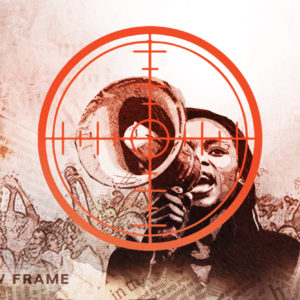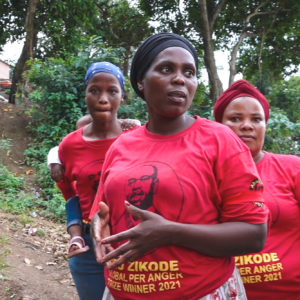Murder most foul
Political killings have become an all too common tool of control in South Africa. It is essential that this grim reality is recognised and opposed.
Author:
13 May 2022

The first time after apartheid that a police murder of an unarmed protester made the news was in 2000 when Michael Makhabane, a student at what was then the University of Durban-Westville, was shot and killed during a protest against exclusions. Much of the media responded by vilifying the students, essentially presenting them as barbarians who had breached the gates. The problem, it was assumed, had to be the students, not the police.
After that protesters were killed by the police at a slowly increasing rate, with a marked upswing from 2004, the year in which the often misnamed phenomenon of “service delivery protests” began to pick up. The murders of two teenagers, Dennis Mathibithi and Nhlanhla Masuku, in Kathlehong early in the year were largely passed over in silence. The murder of Tebogo Mkhonza, also a teenager, at a protest in Intabazwe, Harrismith, that winter did gain some attention, largely because of the startling scale of the protest. But the assumption that the police were virtuous actors who would only kill for good reason was still a standard filter for much of the media and the chattering classes.
This was also the year in which the torture of activists at the hands of the police first became a matter of public record. The Landless People’s Movement held a peaceful protest in Soweto on 14 April, election day, under the banner of “No Land! No Vote!”. The police arrested 57 people and tortured some of them at the police station.
Related article:
In 2005, Noby Ngombane, the head of the Free State government’s policy monitoring and evaluation unit, was murdered in Bloemfontein. Ngombane, initially slandered in the media, was a principled civil servant opposed to the political mafia in the province. He was murdered at home, in front of his five-year-old daughter Zandile, who later died by suicide in 2018.
In 2006, the assassination of independent activists began. That year, a group of former SACP activists backed an independent candidate in a ward in Umlazi, Durban, in the local government elections. At a protest on 2 March, held the day after the elections against what protesters claimed were brazen irregularities in the contested ward, the police shot and killed Monica Ngcobo. She was on her way to work as a waitress at the Durban waterfront. She was 19 years old. The police claimed she was shot in the chest while throwing a stone. It was later shown that she was shot in the back at close range. Two of the leading figures in the campaign in the ward were then murdered. Sinethemba Myeni was shot and killed on 12 April and Mazwi “Komi” Zulu on 3 May.
In 2008, Scorpion Dimane, an anti-mining activist, was assassinated in Mbizana, beginning a period in which the intersection of local political elites, traditional authority and mining capital would result in numerous assassinations, not all of which have been fully documented or brought to public attention.
A turning point
At the same time, police killings of unarmed protesters were steadily escalating. It was not unusual for media reports to not name the victims, whose deaths were often recorded in a cursory way, in a sentence or two in a short article. Police killings became regular events from 2011. This was the year in which video footage of the police murder of Andries Tatane during a protest in Ficksburg was screened on television news, an event that finally began the process of waking the chattering classes up to the realities of political repression.
But despite the shock of Tatane’s televised murder and the televised police massacre of 34 striking miners at Marikana the following year, there is still no comprehensive list of protesters killed by the police after apartheid. The number is certainly well north of a hundred, but that we do not know how many people have been killed, or even the names of all those whose deaths have been noted in media reports, is indicative of the deeply undemocratic sentiments that dominate society.
Related article:
The 2012 assassination of Kevin Kunene, an anti-mining activist in KwaMbonambi in northern KwaZulu-Natal, received very little attention outside of activist circles. However, in that year, the SACP was able to draw some attention to the murder of Bomber “Radioman” Ntshangase, a party leader in Mpumalanga known for his forthright opposition to corruption.
But the assassination of Thembinkosi Qumbela in Cato Crest, Durban, the following year was granted significantly more attention. Qumbela, a mercurial and charismatic figure, had bounced around from one political party to another. He shocked local elites in 2005 by leading a huge march on to the main highway leading into Durban on Freedom Day with the intention of preventing Thabo Mbeki’s cavalcade from reaching the stadium where he was scheduled to speak.
Andile Matshaya, an internal auditor in the Department of Transport in Pietermaritzburg, was assassinated in 2012. And two other auditors, Lawrence Moepi in the public protector’s office in Johannesburg and Moses Tshake in the Department of Agriculture and Rural Development in the Free State, were assassinated the following year.
Unusual convictions
This was also the year in which the assassinations of Abahlali baseMjondolo activists began with the murder of Nkululeko Gwala, also in Cato Crest. In the same year, the police shot and killed 17-year-old Nqobile Nzuza during a protest organised by a local Abahlali branch in Cato Crest. As usual, the police lied, claiming that they were “forced” to shoot while under attack. It later turned out that they had shot Nzuza from behind while she was in flight. In a highly unusual development, a police officer was later convicted and jailed for this murder.
The next year, Abahlali baseMjondolo lost another senior leader when Thuli Ndlovu was assassinated in KwaNdengezi, Pinetown, near Durban. In an equally unusual development, two ANC councillors were convicted for the murder and jailed. Local SACP activist Mobeni Khwela was also murdered in KwaNdengezi that year.
In 2014, Njabulo Ndebele, Sibonelo “John-John” Ntuli and Ntobeko Maphumulo, National Union of Metalworkers of South Africa leaders in Isithebe, KwaZulu-Natal, and Mbuyiselo Phajana Mnguni, the Free State chairperson of the Chemical, Energy, Paper, Printing, Wood and Allied Workers’ Union, were murdered. This was the moment in which the increasingly regular murder of trade unionists began to move beyond the platinum belt. Unionists continue to be murdered around the country.
In August 2016, the SACP contested a local ward against the ANC in Inchanga, KwaZulu-Natal, in the local government elections. They won decisively but at great cost. The party reported that seven of its members had been “shot execution style”. Reports place the total number of deaths as high as 12, with at least one revenge killing of an ANC member, but details are sketchy.
Related article:
This was also the year in which anti-mining activist Sikhosiphi “Bazooka” Rhadebe was assassinated in Xolobeni, emaMpondweni. Rhadebe was the chairperson of the Amadiba Crisis Committee and his death became an international scandal, decisively ending the effectiveness of the ANC’s strategy of spinning activist assassinations as being random criminal murders. The next two years were very bad for Abahlali baseMjondolo, with key leaders S’bonelo Mpeku and S’fiso Ngcobo killed in Lamontville and Mariannhill, Durban.
After a lull in high profile assassinations Fikile Ntshangase, an anti-mining activist, was assassinated in northern KwaZulu-Natal in 2020. The next year Babita Deokaran, a senior and principled official in the Gauteng health department, was assassinated in Johannesburg.
The assassinations of Abahlali baseMjondolo activists stopped shortly after Jacob Zuma was removed from office, but began again with the assassinations of Ayanda Ngila in March and Nokuthula Mabaso last week. Ngila and Mabaso were both important leaders. Mabaso was killed in front of her children. The organisation’s deputy president, Mqapheli Bonono, and its lawyer, Mbalenhle Kubheka, have both received death threats in recent days. Bonono narrowly escaped an assassination attempt at his home two years ago.
Murder, whether by the police or shadowy assassins, is now an entrenched feature of political life in South Africa. It is imperative that a broad consensus is built by all democratic forces to oppose this grim reality.



